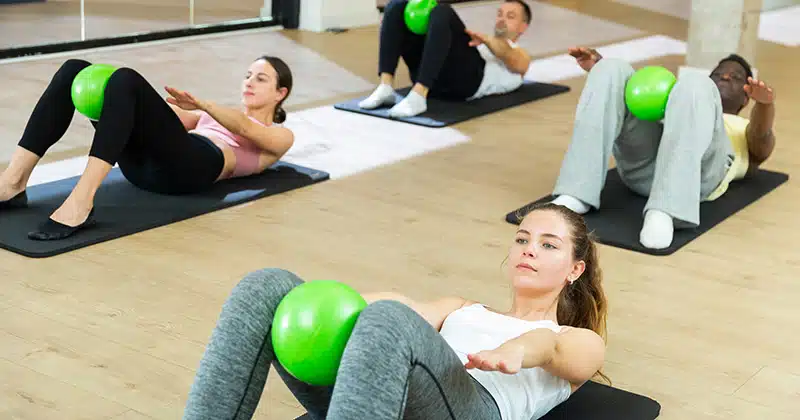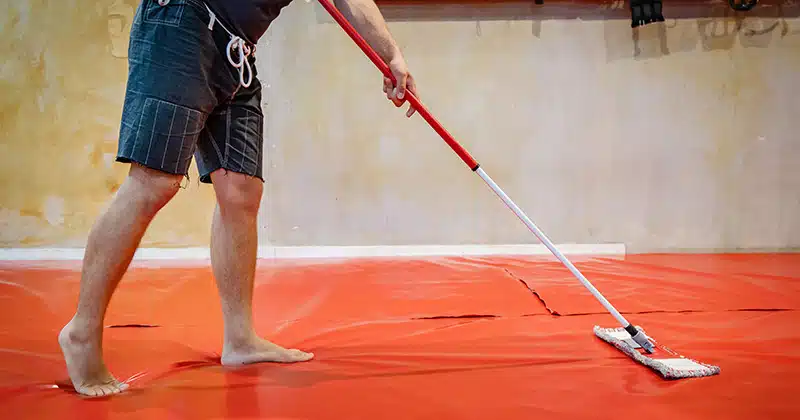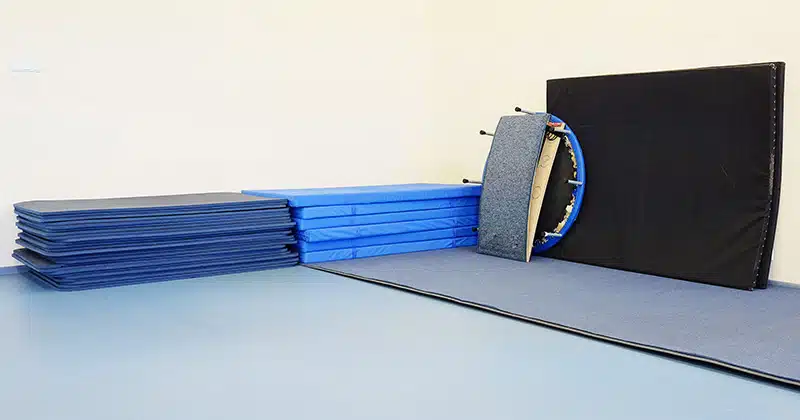Gymnastics mats protect participants and the floor for a number of different activities. They’re a necessary piece of equipment in gymnastics studios and other fitness outlets. But, ensuring that they’re clean after use may confusing. There are so many options out there. Which one works best for your type of mat?
In this article, you’ll earn how to clean gymnastics mats based on their different materials. Get professional tips on how often to clean your studio’s mats and how to prevent dirt and contamination.
Let’s start by determining what type of mat you have.
Types of Gymnastics Mats
Gymnastics mats are used in gymnastics and tumbling academies. They’re also commonly found in dance, yoga, Pilates, martial arts, and fitness studios. Physical therapists use gymnastics mats in their clinics, too.
Different types of mats are used for corresponding activities. Depending on the type of mat used, a unique cleaning process may be recommended.
There are several types of mats, including:
- Small folding or roll-up individual mats—most commonly used for yoga or exercise classes
- Vinyl-topped mats—usually found in impact sports like gymnastics and martial arts
- Carpet-topped mats—not as common, usually found as non-slip surfaces around equipment
- Equipment mats—used under equipment or around weights

Cleaning Frequency
How often should you clean gymnastics mats?
Under normal circumstances, you probably want to adopt a cleaning schedule based on studio usage. Are the mats being used multiple times per day? If so, thorough cleaning at the end of each day may be best. It will prolong the appearance and cleanliness of the mats.
Think about having students give the mats a swift once-over with a sanitizing wipe or spray at the end of each class. This will make the mats fresher and more hygienic for the next group.
Maybe, though, you’re only using your gymnastics mats once per week for one class. In that case, you might only need to clean them every few weeks. You might want to do a deep clean once a month and give them a quicker wipe after weekly classes.
With new mats, it may take a few weeks to determine how often they need cleaning. If you see stains developing or the mats don’t smell fresh, you need to up your cleaning schedule.
One factor that will influence cleaning frequency is what mat users wear during activity sessions.
For example, dressing in apparel that covers the body, like a karate uniform, leaves fewer oils and germs on the mat surface. Conversely, dancing or tumbling in briefs and sleeveless leotards will expose the mat to more dirt and pathogens.
Seasons will play a role in cleaning frequency, as will studio temperature. If students are sweating profusely, the mats will naturally get dirtier faster. Therefore, they’ll need cleaning more often.
How old are the students you’re working with? Adults are generally better about personal hygiene than kids.
Toddlers, preschoolers, and elementary school children, though, aren’t so careful. They’re less conscientious than adults about things like handwashing. And you’re more likely to see runny noses, sticky fingers, and even potty accidents.
RELATED ARTICLE: How to Market a Gymnastics Studio on Social Media
One thing to pay attention to is any outbreak of contagious skin conditions. Common examples include:
- Chicken pox
- Shingles
- Poison ivy, oak, and sumac
- Scabies
- Molluscum contagiosum (MC)
- Ringworm
- Impetigo
- Hand, foot, and mouth disease
- Methicillin-resistant Staphylococcus aureus (MRSA)
Some of these diseases make the rounds in schools and playgroups. Others, like MRSA, are constantly a community problem. This bacterium can cause long-term complications and bone infections. There are even flesh-eating strains.
People can get MRSA anywhere. It’s particularly prevalent in city taxi cabs, doctors’ waiting rooms, and public transportation. Though hospitals are the most prevalent places to contract MRSA, any sites where people share equipment or supplies such as gyms and schools carry the risk.
But resistant staph has made the news over the last few decades. It has ripped through sports teams, including elite college and professional teams. Sharing equipment and towels has been a prime vector of contamination.
RELATED ARTICLE: Trends That Will Affect Your Gymnastics Studio Business in 2024
If you are made aware of a contagious disease in your studio, you may need to use antiseptic treatments for specific pathogens. Sometimes, regular wipes and sanitizing cleaners won’t kill the germs.
For example, you will likely need to use bleach or Lysol to eradicate MRSA. If you’re seeking a more natural agent, tea tree oil is known to have excellent activity against MRSA.

Gymnastic Mat Cleaning Techniques
Here are some helpful tips for cleaning different types of mats:
Small Folding or Roll-Up Individual Mats
These mats are often used for yoga, floor Pilates, and cheer practice. Many studios provide them for students to use during classes.
Cleaning these mats is pretty simple. First, remove dust or dirt with a broom or vacuum. A hand-held vac would be perfect.
Then, wet a cloth or fill a spray bottle with one of these products:
- Hydrogen peroxide or rubbing alcohol, diluted 2 parts cleaner to 1 part water
- Ecore at Home Enviro Care Neutral Disinfectant
- ULINE Cleaner and Disinfectant
Spray and wipe, or wipe the mat. Allow it to air-dry, if possible, before putting it away.
Peroxide can bleach some porous materials. To be safe, test a small corner first for colorfastness.
For lightly used mats, disinfecting wipes available at the pharmacy or grocery store work fine, too. A small amount of diluted dish soap is another choice.
Some students bring their own mats and may want a natural option to use at home. Spraying with a mixture of equal water and vinegar works to remove odors. The mat will smell of vinegar at first, but it fades as the mat air-dries.
Yet another option with small mats is to prevent dirtying the mat in the first place. Absorbent yoga towels and covers protect the mat from sweat, body oils, and other contaminants. They can go in the washing machine any time they need cleaning.
Vinyl-Topped Mats
Larger practice mats often come with an upper surface made of vinyl. These are ideal for group tumbling, acrobatics, self-defense practice, and cheerleading. They can also be cleaned with any of the solutions listed above. Again, let the mat air-dry for the best results.
Be careful about not spraying too much fluid around any seams. You don’t want the liquid to accumulate inside the mat and encourage mold growth.
If you need to do a heavy cleaning of these mats, apply a waterproofing treatment to the seams or cover them with waterproof tape.
Do you have an extra-large vinyl-topped mat like the type used for competitions? Instead of hand wiping, use a dedicated floor mop to cover more area quickly.
RELATED ARTICLE: How to Run a Successful Gymnastics Studio
Carpet-Topped Mats
The best way to clean these mats is to vacuum them first. Then apply carpet shampoo and clean them like you would a regular carpet. Some studios elect to have a professional carpet cleaner do a deep cleaning a couple of times per year.
The drying time for these mats can be a little longer than with vinyl-topped mats. So, you may not be able to clean carpet-topped mats as often. To shorten the process, you can rotate your mats to use clean ones while another batch is drying.
Equipment Mats
Some studios use squishy foam mats under equipment like weight benches or Pilates reformers. They help protect the floor and prevent slipping.
Most of these mats can be cleaned using the method for vinyl-topped mats. These are usually fairly heavy-duty.
You can also hose them down if need be. In fact, some studios buy thick mats made for stalls that are designed for hose cleaning.
Be careful about hosing or pressure-washing mats that aren’t made for this extreme level of cleaning. Always check with the manufacturer’s instructions first.
Cleaning vs. Sanitizing
Cleaning is not the same thing as sanitizing. Cleaning removes debris and stains. Sanitizing (or disinfecting) removes germs.
Wiping and hosing are generally cleaning methods. However, spraying mats with ULINE or Ecore adds an element of sanitizing that may be preferable in high-use scenarios.
Any bloodstains from scrapes or accidents need to be cleaned up right away. After cleaning the stain, apply sanitizer for extra good measure. You don’t want bloodstains to become permanent, nor do you want the risk of a biohazard present.

6 Long-Term Maintenance Tips to Keep Your Gymnastics Mats in Great Shape
You can invest quite a bit in purchasing gymnastics mats for your studio. Therefore, you want to keep them in good shape for as long as possible. Here are six strategies you can use to prolong their lifespan:
1. Bandage Wounds
Encourage students to cover any cuts or wounds when they’re in your studio. This will minimize bloodstains and germs on your mats.
2. Remove Shoes
Don’t walk on your mats while wearing street shoes. Instead, only allow mat use barefoot, in socks, or when wearing special shoes for indoor dance or sports.
3. Circulate the Air
To help your mats dry after cleaning or sanitizing, use fans or an air mover to evaporate liquid faster.
4. Ask for Help
Keep sprays and disinfecting wipes handy if many people use your gymnastics mats frequently. Post a sign asking users to clean or sanitize their mat after use.
5. Be Proactive
Consider applying a commercially available protective spray on your mats if possible. Products like Zebra SportSense reduce the need for deep cleaning and discourage the growth of bacteria for months at a time.
6. Stick to a Schedule
Use studio management software to keep a schedule of mat cleaning. You’ll know when you last did a deep cleaning and who is responsible for this task.
RELATED ARTICLE: How to Use ChatGPT to Market Your Studio Business


